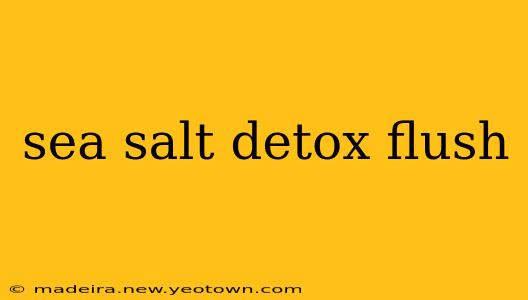The internet is awash with claims about the miraculous detoxifying powers of a sea salt flush. From promising weight loss to clearing acne, the purported benefits are numerous. But is there any scientific truth behind these bold statements? Let's dive deep into the world of sea salt flushes, separating fact from fiction and exploring the potential risks and benefits.
My name is Evelyn Reed, and I've spent years researching natural health remedies. While I believe in the power of holistic wellness, I'm also a firm believer in evidence-based practices. Let's explore the sea salt detox flush together, examining the science behind it and the potential implications for your health.
What is a Sea Salt Flush?
A sea salt flush typically involves dissolving a small amount of sea salt (usually unrefined, like Himalayan pink salt or Celtic sea salt) in a large glass of warm water and drinking it on an empty stomach. Proponents claim this concoction helps cleanse the body by flushing out toxins and improving digestion. The idea is that the salt draws water into the intestines, stimulating bowel movements and eliminating waste products.
Does a Sea Salt Flush Actually Detoxify Your Body?
This is where things get tricky. Your body already has a highly efficient detoxification system – your liver and kidneys. These organs work tirelessly to filter out toxins and waste, making a sea salt flush largely redundant. While a sea salt flush might temporarily increase bowel movements, it doesn't magically remove toxins your liver and kidneys haven't already addressed. The notion of a "detox" as a singular event is largely a marketing ploy. True detoxification is a continuous process handled by your internal organs.
How Does Sea Salt Affect the Body?
Sea salt, despite its name, is mostly sodium chloride. Sodium plays a vital role in regulating fluid balance, nerve impulses, and muscle contractions. However, consuming too much sodium can lead to water retention, high blood pressure, and other health problems. While a single sea salt flush likely won't cause significant harm to a healthy individual, regularly indulging in such practices is not advisable.
What are the Potential Risks of a Sea Salt Flush?
H2: Can a sea salt flush cause dehydration?
Yes, ironically, a sea salt flush can lead to dehydration. While it initially increases bowel movements, it can also deplete your body of essential fluids if not balanced with adequate water intake. The salt's osmotic effect draws water into the intestines, potentially leading to dehydration if you don't replenish those fluids.
H2: Is a sea salt flush safe for everyone?
No, a sea salt flush is not safe for everyone. Individuals with heart conditions, kidney problems, or those on a low-sodium diet should strictly avoid it. Consult your doctor before trying any detox regimen, especially if you have pre-existing health conditions.
H2: Can a sea salt flush help with weight loss?
Any weight loss experienced after a sea salt flush is likely due to temporary fluid loss and bowel movements, not actual fat loss. It's not a sustainable or healthy way to manage weight. For sustainable weight loss, focus on a balanced diet and regular exercise.
H2: Are there any side effects of a sea salt flush?
Possible side effects include nausea, vomiting, diarrhea, and electrolyte imbalances. These can be especially problematic for those with underlying health conditions.
The Bottom Line: Is a Sea Salt Flush Worth It?
The evidence does not support the claims surrounding sea salt flushes. While a single flush is unlikely to cause significant harm to a healthy individual, it's not a necessary or effective way to detoxify your body. Your body already possesses incredible self-cleaning mechanisms. Focus on a healthy diet, regular exercise, and adequate hydration for true, long-term wellness. If you have concerns about your health, consult a doctor or registered dietitian before trying any unconventional health remedies. They can provide personalized advice based on your individual needs and health history.

